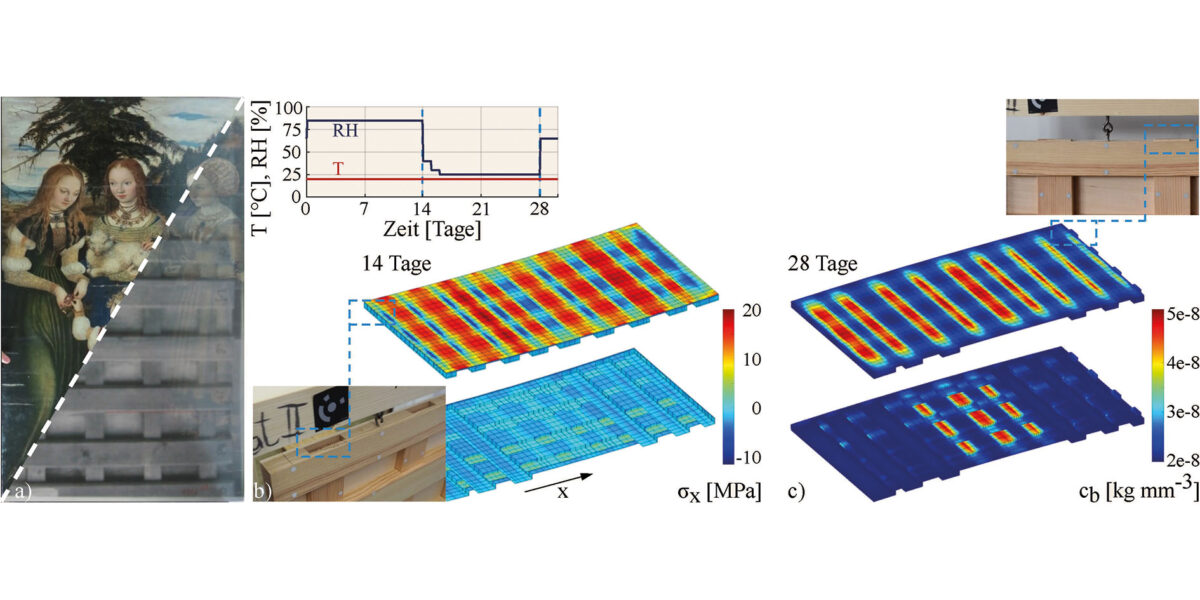Realitätsnahe Modellierung und Simulation von Strukturen aus Holz

Holztafelbild mit historischer Parkettierung (Staatliche Kunstsammlungen Dresden), b) simulierte Feuchtebelastung und Auswertung der Spannungen in Tafellängsrichtung σx nach 14 Tagen, und c) Auswertung der Konzentration des gebundenen Wassers cb nach 28 Tagen (jeweils Vorder- und Rückseite) sowie zugehörige Detailfotos der Repliken im Experiment. Grafik: J. Stöcklein Panel painting with historical support (Dresden State Art Collections), b) simulated hygric load and evaluation of stresses in the panel’s longitudinal direction σx after 14 days, and c) evaluation of the concentration of bound water cb after 28 days (front and rear side, respectively), as well as corresponding photos of details of the replicas in the experiment. Source: J. Stöcklein
D. Konopka, R. Fleischhauer, F. N. Schietzold, D. Rahmi, J. Stöcklein, M. May, M. Kaliske
Bauingenieur Jahrgang 99 (2024) Heft 07–08
Publikationsdatum: 04.07.2024
doi.org/10.37544/0005-6650-2024-07-08-67
Zusammenfassung Neue Methoden und Modelle zur Analyse von Holztragwerken bei irreversiblen Schädigungsprozessen werden anhand beispielhafter Simulationsergebnisse illustriert. Dazu gehören zum einen Methoden zur Simulation von hygro-mechanischen Langzeitbeanspruchungen und von Rissausbreitungen auf Grundlage repräsentativer Risselemente. Zum anderen werden neue Ansätze aufgezeigt, mit welchen Einbringprozesse von Nägeln sowie hygro-thermo-mechanische Holzumformung – unter großen Deformationen – realitätsnah simuliert werden können. Für aus solchen Holzumformungen erzeugte holztechnologische Produkte werden des weiteren Ansätze zur Analyse der Unschärfe vorgestellt, welche verlässliche Bewertungen von Tragstrukturen ermöglichen. Die präsentierten Beispiele verdeutlichen die Stärke der Methoden für die numerische Analyse praxisrelevanter Strukturen aus Holz unter Berücksichtigung eines hochkomplexen, nichtlinearen Materialverhaltens eines Baustoffs, dessen Eigenschaften stets natürlicher Streuung unterliegen.
Realistic Modelling and Simulation of Timber Structures
Abstract Simulation results are presented to illustrate new methods and models for analyzing irreversible damage processes in wooden structures. The new developments include methods for the simulation of hygro-mechanical long-term loading, of crack propagation based on representative crack elements, of the insertion of nails and of hygro-thermo-mechanical wood forming under large deformations. Furthermore, approaches for analyzing the uncertainty of material characteristics of wooden structures made by wood forming processes are presented, which enable a reliable evaluation of structural systems. The examples presented illustrate the strength of the methods for the numerical analysis of structures of practical relevance made of wood, taking into account highly complex, non-linear material behaviour of a building material that exhibits naturally scattering characteristics.
